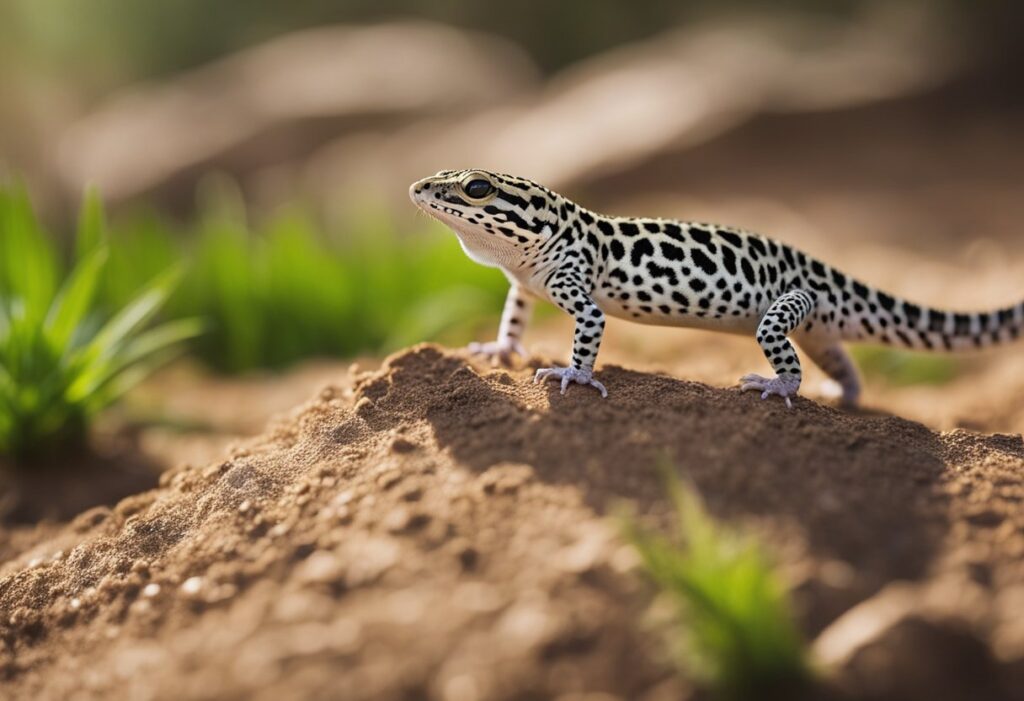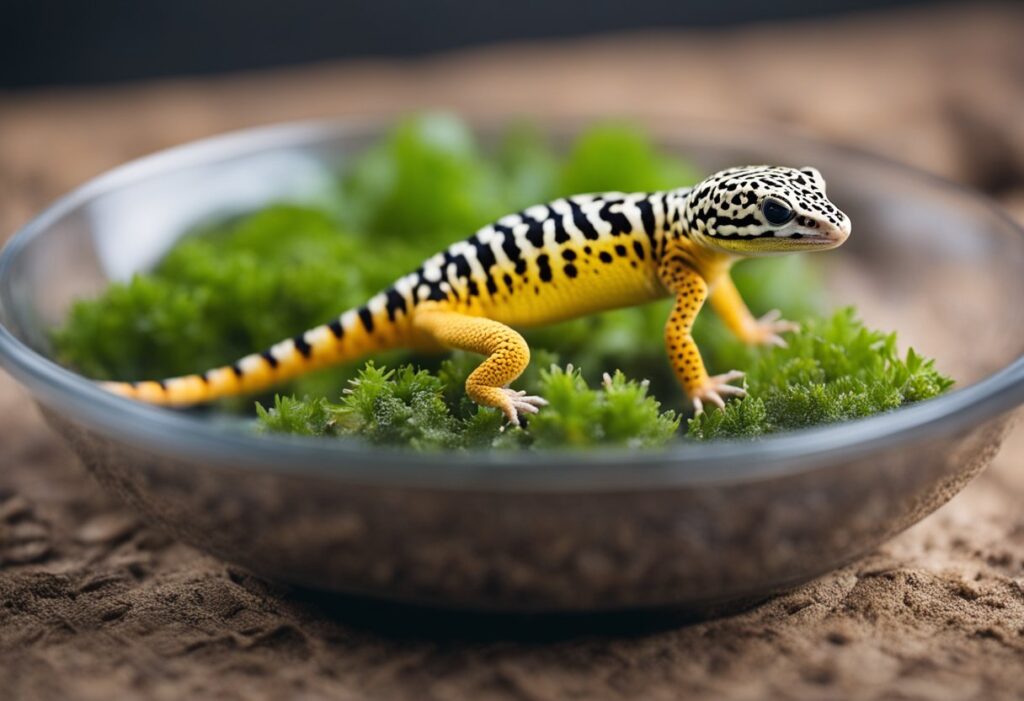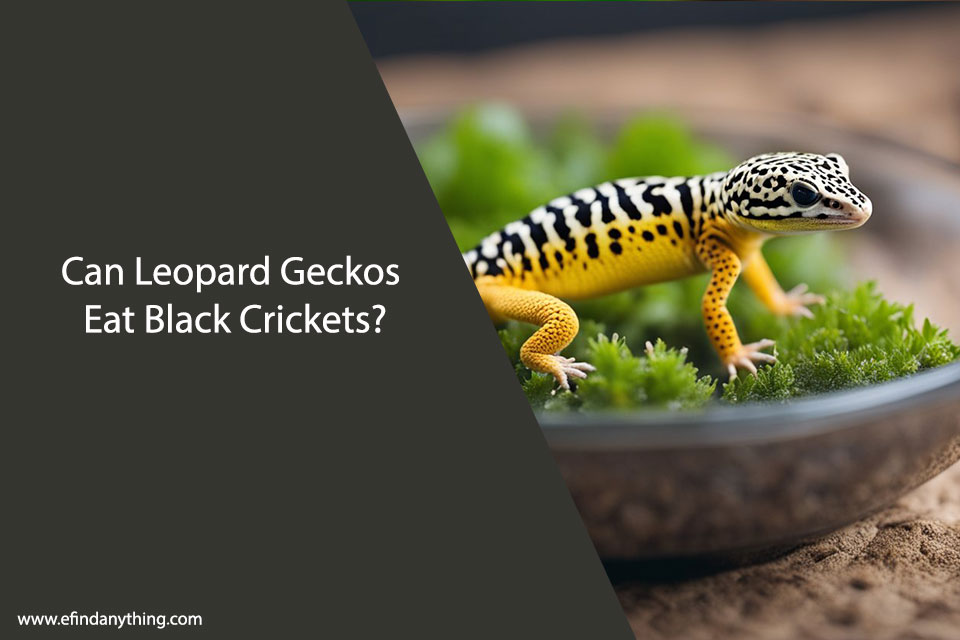Leopard geckos are popular pets due to their docile nature and low maintenance requirements. However, as with any pet, it’s important to ensure they are receiving a balanced and nutritious diet. One common question among leopard gecko owners is whether or not they can eat black crickets.
The short answer is yes, leopard geckos can eat black crickets. In fact, crickets are a staple part of their diet in the wild. However, it’s important to ensure the crickets are properly gut-loaded and dusted with calcium and other necessary supplements before feeding them to your gecko. In this article, we will explore the benefits and potential risks of feeding black crickets to leopard geckos and provide tips on how to do it safely and effectively.
Table of Contents
Dietary Benefits of Black Crickets for Leopard Geckos

As avid hunters, leopard geckos require a diverse diet to maintain their health and wellbeing. Black crickets are an excellent source of protein, fiber, and essential vitamins and minerals that contribute to a balanced diet for leopard geckos.
Protein is an essential component of a leopard gecko’s diet, as it helps to build and repair body tissues. Black crickets are rich in protein, with approximately 20-25% of their body weight consisting of protein. This makes them an ideal food source for leopard geckos, as they require a high protein intake to support their active lifestyles.
In addition to protein, black crickets also contain fiber, which aids in digestion and helps prevent constipation. They are also a good source of calcium, which is essential for strong bones and overall health. Calcium is particularly important for female leopard geckos, as they require higher levels of calcium for egg production.
Overall, black crickets are a nutritious and beneficial addition to a leopard gecko’s diet. When feeding black crickets to your leopard gecko, it is important to ensure that they are gut-loaded with nutritious foods and dusted with calcium powder to provide optimal nutrition.
Feeding Guidelines for Leopard Geckos

Leopard geckos are insectivores, and black crickets are a common staple in their diet. However, it is important to follow certain guidelines to ensure that your leopard gecko is receiving a balanced and nutritious diet.
Frequency of Feeding Black Crickets
Adult leopard geckos should be fed every other day, while juvenile leopard geckos should be fed daily. It is important to not overfeed your leopard gecko, as obesity can lead to health problems.
Appropriate Size of Black Crickets
The size of the black crickets you feed your leopard gecko should be appropriate for their size. A good rule of thumb is to feed crickets that are no larger than the space between your leopard gecko’s eyes. This ensures that the crickets are not too large for your leopard gecko to digest, which can cause impaction.
Supplement Coating for Crickets
In addition to feeding your leopard gecko black crickets, it is important to supplement their diet with calcium and vitamin D3. This can be done by dusting the crickets with a calcium and vitamin D3 supplement before feeding them to your leopard gecko. This helps to prevent health problems such as metabolic bone disease.
By following these feeding guidelines, you can ensure that your leopard gecko is receiving a balanced and nutritious diet that will promote their health and longevity.
Preparing Black Crickets for Consumption

When feeding leopard geckos, it is important to ensure that their food is properly prepared to ensure the health and wellbeing of your pet. In this section, we will discuss how to prepare black crickets for consumption.
Gut-Loading Black Crickets
Gut-loading is the process of feeding nutritious foods to insects, which in turn increases the nutritional value of the insects for your pet. Prior to feeding your leopard gecko black crickets, it is recommended to gut-load the insects for at least 24 hours. This can be done by feeding the crickets a variety of fruits and vegetables such as carrots, sweet potato, and apples.
Hygiene and Handling
It is important to maintain proper hygiene when handling black crickets to prevent the spread of disease and bacteria. Always wash your hands before and after handling the insects, and use clean utensils and containers.
When storing black crickets, it is recommended to keep them in a well-ventilated container with a lid to prevent escape. The container should be cleaned regularly and any uneaten crickets should be removed to prevent them from becoming a breeding ground for bacteria.
In conclusion, preparing black crickets for consumption requires proper gut-loading and hygiene practices to ensure the health of your leopard gecko. By following these guidelines, you can provide your pet with a nutritious and safe diet.
Potential Risks and Considerations
When considering feeding black crickets to leopard geckos, there are a few potential risks and considerations to keep in mind. In this section, we will discuss two of the most important ones: parasite transmission and chitin and digestion issues.
Parasite Transmission
Black crickets can carry parasites that can be harmful to leopard geckos. These parasites can cause a range of health problems, including diarrhea, lethargy, and even death. To minimize the risk of parasite transmission, it is important to source your crickets from a reputable supplier and to quarantine them for a few days before feeding them to your gecko. Quarantining the crickets will give you time to observe them for any signs of illness or parasites.
Chitin and Digestion Issues
Another potential issue with feeding black crickets to leopard geckos is chitin. Chitin is a tough, indigestible substance found in the exoskeletons of insects, including crickets. If a leopard gecko eats too much chitin, it can lead to digestive issues, such as impaction or constipation. To minimize this risk, it is important to feed your gecko a varied diet that includes other insects, such as mealworms and waxworms, which have lower levels of chitin. Additionally, you can remove the legs and wings of the crickets before feeding them to your gecko to reduce the amount of chitin they consume.
Overall, while black crickets can be a nutritious and tasty food for leopard geckos, it is important to be aware of the potential risks and considerations associated with feeding them. By taking the necessary precautions and ensuring a varied diet, you can help keep your gecko healthy and happy.
Alternatives to Black Crickets

When it comes to feeding leopard geckos, black crickets are a popular choice due to their high protein content and availability. However, there are other insect prey options and commercial gecko diets that can provide a balanced and varied diet for your pet.
Other Insect Prey Options
In addition to black crickets, there are several other insects that can be fed to leopard geckos. Some of these include:
- Dubia Roaches: Dubia roaches are a nutritious and easy-to-digest insect that can be fed to leopard geckos. They are high in protein, low in fat, and have a soft exoskeleton that makes them easy to digest.
- Mealworms: Mealworms are a common feeder insect that are high in protein and easy to find. However, they have a hard exoskeleton that can be difficult for leopard geckos to digest, so they should be fed in moderation.
- Waxworms: Waxworms are a high-fat feeder insect that should be fed sparingly as a treat. They are soft-bodied and easy to digest, making them a good option for leopard geckos with digestive issues.
Commercial Gecko Diets
In addition to feeding live insects, there are also several commercial gecko diets available that can provide a balanced and complete diet for your pet. Some of these include:
- Repashy Superfoods: Repashy Superfoods are a powdered diet that can be mixed with water to create a gel-like substance that leopard geckos can eat. They come in a variety of flavors and are formulated to provide a balanced diet.
- Pangea Fruit Mix: Pangea Fruit Mix is a powdered diet that is made with real fruit and insects. It is high in protein and fiber, and can be fed as a complete diet or as a supplement to live insects.
- Zoo Med Crested Gecko Diet: Zoo Med Crested Gecko Diet is a powdered diet that is formulated for crested geckos, but can also be fed to leopard geckos. It is high in protein and vitamins, and can be fed as a complete diet or as a supplement to live insects.
In conclusion, while black crickets are a popular choice for feeding leopard geckos, there are several other insect prey options and commercial gecko diets that can provide a balanced and varied diet for your pet. By offering a variety of foods, you can ensure that your leopard gecko gets all the nutrients they need to thrive.
Frequently Asked Questions
What are the risks of feeding wild crickets to leopard geckos?
Feeding wild crickets to leopard geckos can be risky as they may carry parasites or diseases. Additionally, wild crickets may have been exposed to pesticides or other harmful chemicals. Therefore, it is recommended to only feed captive-bred crickets to leopard geckos.
How does the size of the cricket affect a leopard gecko’s diet?
The size of the cricket should be appropriate for the size of the leopard gecko. Feeding a leopard gecko crickets that are too large can cause digestive issues, while feeding crickets that are too small may not provide enough nutrition. It is important to choose the right size of cricket for your leopard gecko.
Is it safe to feed leopard geckos dead crickets?
Yes, it is safe to feed leopard geckos dead crickets. However, it is important to ensure that the crickets are fresh and have not been contaminated by bacteria or fungi. Dead crickets should be removed from the enclosure if they are not consumed within a few hours.
What precautions should be taken when introducing crickets into a leopard gecko’s habitat?
When introducing crickets into a leopard gecko’s habitat, it is important to ensure that the crickets are healthy and free from parasites. Additionally, the enclosure should be cleaned regularly to prevent the buildup of bacteria and other harmful microorganisms. It is also important to monitor the leopard gecko’s behavior to ensure that they are consuming the crickets and not ignoring them.
How often should leopard geckos be fed crickets?
Leopard geckos should be fed crickets 2-3 times per week. The number of crickets per feeding will depend on the size and age of the leopard gecko. It is important to avoid overfeeding as this can lead to obesity and other health issues.
What is the nutritional value of black crickets for leopard geckos?
Black crickets are a good source of protein and other essential nutrients for leopard geckos. They also provide hydration as they contain a high level of moisture. However, it is important to ensure that the crickets are gut-loaded with nutritious food prior to feeding to ensure that the leopard gecko receives optimal nutrition.





